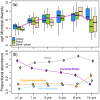Patterns in the skin microbiota differ in children and teenagers between rural and urban environments
- PMID: 28361981
- PMCID: PMC5374497
- DOI: 10.1038/srep45651
Patterns in the skin microbiota differ in children and teenagers between rural and urban environments
Abstract
The composition of human microbiota is affected by a multitude of factors. Understanding the dynamics of our microbial communities is important for promoting human health because microbiota has a crucial role in the development of inflammatory diseases, such as allergies. We have studied the skin microbiota of both arms in 275 Finnish children of few months old to teenagers living in contrasting environments. We show that while age is a major factor affecting skin microbial composition, the living environment also discriminates the skin microbiota of rural and urban children. The effect of environment is age-specific; it is most prominent in toddlers but weaker for newborns and non-existent for teenagers. Within-individual variation is also related to age and environment. Surprisingly, variation between arms is smaller in rural subjects in all age groups, except in teenagers. We also collected serum samples from children for characterization of allergic sensitization and found a weak, but significant association between allergic sensitization and microbial composition. We suggest that physiological and behavioral changes, related to age and the amount of contact with environmental microbiota, jointly influence the dynamics of the skin microbiota, and explain why the association between the living environment skin microbiota is lost in teenager.
Conflict of interest statement
The authors declare no competing financial interests.
Figures



References
-
- Pasparakis M., Haase I. & Nestle F. O. Mechanisms regulating skin immunity and inflammation. Nature reviews. Immunology 14, 289–301 (2014). - PubMed
-
- Belkaid Y. & Segre J. A. Dialogue between skin microbiota and immunity. Science 346, 954–959 (2014). - PubMed
-
- Fyhrquist N. et al. Acinetobacter species in the skin microbiota protect against allergic sensitization and inflammation. The Journal of allergy and clinical immunology 134, 1301–1309.e11 (2014). - PubMed
Publication types
MeSH terms
LinkOut - more resources
Full Text Sources
Other Literature Sources
Medical

